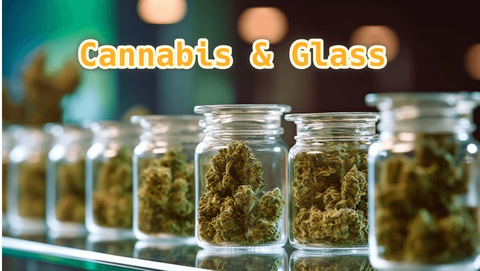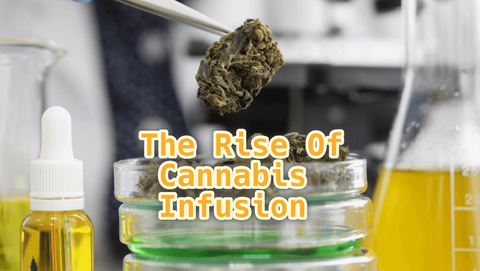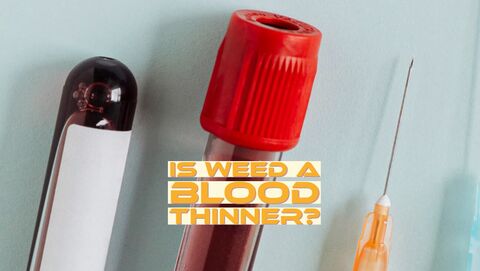Latest Blog Posts
Top rated

How Long Does Weed Stay In Your System?
All About THC Detectability
Marijuana may be recommended as a medical treatment in certain instances. Patients who suffer from chronic pain may find relief from the chemical molecules known as THC and CBD. Cannabis, a plant that may be used to make hemp products, is more often known as an illegal drug. On the other side, cannabis has seen a surge in popularity as a potential therapy for a variety of medical conditions in recent years, notably as a painkiller.

The molecule known as tetrahydrocannabinol, or THC for short, is derived from the hemp plant and is the primary psychoactive component of cannabis. THC is responsible for the intoxicating effects of both hashish and marijuana.
The cannabis plant contains more than one hundred different cannabinoids, which are chemicals with biological activity. THC is an abbreviation that stands for delta-9-tetrahydrocannabinol, which is one of several plant compounds. Two different THC acids may be found in the plant, both of which contain THC.
Who Specifically Benefits from Marijuana Use?
Although this is not always the case, there is some evidence that cannabis therapy may be helpful even at the lowest amounts. Even for the medical professionals, it is not always obvious which patients will profit from it and which will not. According to the findings of recent studies, cannabis remains the most effective medicine for nerve pain (neuropathy). Cannabis therapies seem to be beneficial for the treatment of multiple sclerosis (MS), significant weight loss caused by tumor sickness (also known as tumor cachexia), and palliative care.
What Medical Professionals Say
According to medical professionals, low-dose dronabinol drops, for instance, have been shown to be beneficial for older people who suffer from chronic pain. This is due, in part, to the fact that they have an endocannabinoid system in their bodies. They alleviate pain, improve one's mood, and provide for a more restful night's sleep, all of which contribute to an overall improvement in one's quality of life. Because of the low dosage, the medicines do not provide an intoxicating effect and do not lead to addiction.
Because these drugs do less harm to the liver and kidneys than other options, they are an ideal alternative for people of advanced age. Because of this, medical professionals prescribe them to patients who are suffering from renal insufficiency or liver failure.
Benefits of Using Cannabis
There has not been sufficient study of a high enough quality to establish whether or not cannabis is effective. According to studies, drugs that include THC may help treat symptoms such as chronic pain, muscle cramping, nausea, and even weight loss. In addition, the majority of the time it had a significant effect on even more serious conditions.
Cannabis does not ease pain that comes on suddenly. It is possible that it will take some time to become widespread. Patients suffering with inflammatory bowel disease, Parkinson's disease, movement issues, tremors, Huntington's disease (an extremely uncommon hereditary ailment), or bladder weakness as a result of multiple sclerosis have not shown any evidence that cannabis is useful to their condition.
The appropriate care that should have been paid to other diseases has not been given. Cannabidiol is only approved for the treatment of a very specific kind of epilepsy at this time; nonetheless, it is being promoted as a remedy for a broad variety of other conditions.
Spasms
Muscle and joint spasms are a potential symptom of multiple sclerosis (MS), which might occur in certain patients. Cannabinoids may be able to decrease these moderate to severe spasms, as shown by several studies and including twice as many test participants as those who were given placebos. At the same time, only female patients reported a decrease in the intensity of their pain. The calming impact on muscles is there, despite the fact that it has not been shown to the same extent as the effect on paraplegic spasms.
Cramps may be excruciatingly painful and can be caused by constant tension on the muscles, especially in the arms and legs of Parkinson's disease patients. Cannabis has been proved to ease severe cramps to a large degree, as is seen in the video that can be found below.
Anti-inflammatory
Cannabinoids, in addition to their analgesic impact, may also have an anti-inflammatory effect on inflammatory pain syndromes such as ulcerative colitis (a chronic bowel illness) or arthritis. This would be in addition to the analgesic effect that they have.
The CB2 receptor in the central nervous system has been demonstrated to be activated by the chemical beta-caryophyllene, which makes up between 12 and 35 percent of the essential oil of the cannabis plant, according to a research conducted at ETH. This, in turn, results in a reduction in the release of cytokines that promote inflammation.
Depression
The results are not quite clear in this regard. Cannabis usage throughout adolescence has been linked to an increased risk of acquiring mental health conditions such as anxiety and depression for some time now. This association has been recognized for some time.
There is little evidence to support this link among adult users. In contrast, many people who use cannabis report that it has an impact similar to that of an antidepressant and reduces their levels of anxiety. Cannabinoids have been hypothesized to have an antidepressant impact; however, clinical trials have not yet shown conclusive evidence of this effect.
Glaucoma
One of the most important factors in the development of glaucoma is an elevation in the eye's intraocular pressure. Cannabinoids have been shown to have a hypotensive impact on the eye since 1971, specifically on the intraocular pressure.
Additional research has shown that taking THC in pill form or smoking cannabis may lower intraocular pressure by anywhere from 25 to 30 percent on average, and in some instances by as much as 50 percent.
A Defense Mechanism Against Natural Adversaries
Around the reproductive organs of the plants, in the flowers of the female plant, and in the resin glands of the bud, the concentration is very high. This chemical is used by the cannabis plant as a defense mechanism against natural adversaries such as bacteria, viruses, and parasites.
On the other side, people use the intoxicating effect of the psychoactive chemical for their own purposes. This may take the shape of consumption, such as inhalation of rolled cigarettes (joints), or oral intake in the form of cookies (so-called space cookies). It is also a possibility that people who are very sick may be given prescription drugs.
Weed: What are The Steps That the Body Takes to Metabolize it?
Hashish and marijuana are the two most common forms in which weed is taken in for consumption. Hashish, often known as "dope," is the pressed resin of the cannabis plant, while marijuana, sometimes known as "grass," is the dried flowers and leaves of the hemp plant. Both are derived from the same plant.
Either smoking or ingesting the drugs via food and drink is acceptable. THC itself is processed in a very short amount of time. As a consequence of this, the active component is absorbed into the circulation, where it then binds to cannabinoid receptors in the brain and the central nervous system. This contributes to the impact of being intoxicated.
An Increase In the Amount Of Dopamine
When cannabis and its primary psychoactive components, tetrahydrocannabinol (THC) and cannabidiol (CBD), are ingested, the question becomes: how precisely does the mechanism of action work? When a cannabinoid binds to one of its specialized receptors, such as CB1 or CB2, one of the effects that follows is an inhibition of the GABAergic interneuron.
This, in turn, prevents the GABAergic interneuron from having an inhibiting influence on the dopaminergic neuron. As a consequence, there was an increase in the amount of dopamine that was released in the nucleus accumbens of the mesolimbic reward system in the cerebrum.
The following possible initial consequences might show themselves:
- euphoria, often accompanied with what are known as "laughing flashes."
- sedative and hallucinatory effects of relaxation
- passivity, suppression of drive, and increased hunger or cravings are possible side effects of the medicine as it continues.
THC may be Detected for a Pretty Long Time
THC is known to store itself in fatty tissue since it is a lipophilic, or fat-loving, chemical. THC-carboxylic acid is produced as a byproduct of the metabolism of THC. This breakdown product has a substantially longer half-life than THC itself and may be detectable in bodily fluids for weeks after the last ingestion of cannabis even though THC itself has a much shorter half-life. Because of this, the THC may be detected for a pretty long time.
Detectability of THC
The effects of intoxication brought on by smoking cannabis often last anywhere from one to four hours. If you take it by mouth, the impact will typically wear off after a maximum of ten hours. However, even after the intoxicating effects of cannabis have worn off, there is a possibility that THC residues will still be present in the body and will show up on a drug test.
THC and its metabolites may be identified with the use of a number of different drug tests. For example, THC quick testing using test strips are used in the administration of traffic restrictions.
If the amount being tested is more than a predetermined threshold, also known as the cut-off value, then it is reasonable to presume that drug use occurred. In addition to the level of consumption itself, some laboratory technologies, such as gas chromatography-mass spectrometry, may also be used to assess the kind of consumption as well as the frequency of consumption.
Different Factors are Considered
The length of time that THC may be detected varies on a number of different factors:
- quantity as well as the regularity of consumption.
- interval of time between ingestion of THC and subsequent drug test
- blood test, urine test, or hair sample — these are the several types of drug tests.
- the individual's overall health and well-being.
How Long Does it Take for the Weed to Become Detectable in The Blood?
The length of time it takes for weed to become detectable in blood plasma ranges from roughly four to six hours, depending on how often the chemical is used and how much of it is consumed. After smoking a cannabis cigarette with a modest dosage, the only trace of THC that may be found is around 7.2 hours later. When using a cannabis cigarette with a high dosage, the limit of detectability is reached after around 12.5 hours.
THC-carboxylic acid, on the other hand, may be found in the plasma for a much longer amount of time after it has been metabolized. THC may be detected in the system anywhere from one to three days after a single ingestion.
In individuals who have a history of heavy THC usage, traces of THC-carboxylic acid may be seen in the blood plasma three to seven days after their most recent dose of the psychoactive substance. In cases of chronic use, a positive blood test result is possible even after an extended period of time has passed since the last time THC was consumed.
How Long Does it Take for Weed to Become Detectable in Urine?
Because weed can be identified in urine for a much longer period of time than it can, for example, be detected in blood, the pee test is by far the most popular technique for detecting THC. Even after just one use, the breakdown product known as THC-carboxylic acid may be found in the urine between 24 and 36 hours later.
The detection time is around five to seven days when there is recurrent usage of the substance. After six to eight weeks, a urine test may still reveal frequent cannabis use; in the event of continuous intake, THC can be found for as long as twelve weeks after the last time cannabis was used.
How Long Does it Take for Weed to Become Noticeable in Hair?
Analysis of hair is yet another technique that may be used in the search for traces of THC. During the process of hair development, the products of THC's breakdown are integrated into the matrix of the hair. Even in theory, it should be possible to identify them there for a very extended period of time.
A hair will grow around one centimeter every single month on average. Therefore, an uptake of THC that occurred twelve centimeters and one year ago might still be detectable in a hair that is twelve centimeters long.

However, the THC test that uses hair samples is notoriously unreliable and imprecise. On the one hand, even consistent usage is often not spotted by authorities. On the other hand, there is always the possibility of obtaining false-positive findings, such as when using a shampoo on one's hair that includes substances that are chemically similar to THC. Moreover, THC is detected in forensic medicine by blood and urine tests.
Utmost Significance for Motorists
THC may be found in the body even after the euphoric effects of the drug have worn off, which may seem counterintuitive. This is of utmost significance for motorists who get behind the wheel after having used cannabis and find themselves in a situation requiring a traffic stop. The blood or urine test may show a positive result even though the individual feels perfectly sober and is physically capable of driving.
Driving under the influence of THC in Flensburg can result in a hefty fine, points on your driving record, and even a possible suspension of your license. Driving under the influence of narcotics is a criminal violation, and there is the possibility that proper procedures might be taken against the driver if the driving even puts other people on the road in risk.
Determining the Passage of Time is Simplest Using Human Hair
How long does it take for the effects of cannabis to leave your system? THC may be found in bodily fluids such as urine for at least 30 days after ingestion of the drug. It is possible for it to last for up to three months when used often.
THC and cannabis may be detected for a longer period of time in the systems of those who are heavy or chronic users. Cannabis consumers who ingest less of the drug will have lower levels of THC lingering in their bodies for shorter periods of time.
In most cases, determining the passage of time is simplest using human hair. A positive result for cannabis usage on a hair test is possible even if the test was conducted many months after the last time the subject used cannabis. As mentioned above, THC may be detected in a person's blood, urine, perspiration, and oral fluid in addition to the test that is performed on their hair.
How Exactly Does Your System Go about Detecting The Presence of THC?
As a result of the misguided war on cannabis, many managers have found themselves in the situation of needing to test their staff to see whether they have used cannabis. They have access to a wide variety of different kinds of THC tests. The following is a list of some of them, along with some technical information on the efficacy of their use.
Blood Tests to Detect THC And Cannabis Usage
Many people are interested in this question: how long does the psychoactive compound THC remain active in your blood system? According to the findings of this research, which included 25 people who regularly used cannabis, between two and seven days. After seven days, the presence of THC was only detected in the blood of chronic cannabis users who used the drug regularly.
THC and Cannabis Usage May Be Detected in The Urine Using Testing
Some are curious about the length for an urine test to show that one has THC in the system. A urine test may reveal even a single usage of cannabis anywhere from two to seven days after the occurrence. According to the findings of certain research, however, chronic cannabis users may have positive urine tests for up to two months after their last use. It is generally accepted that the cutoff occurs at around three months.
After THC is used, the body converts it into a metabolite called THC-COOH, which is then stored in fat cells. It is gradually released from fat cells in a manner that makes it straightforward for urine tests to pick up on its presence. Because of this, those who are leaner and have less fat stored in their bodies are more likely to pass the THC urine test sooner than those who have large fat stored in their bodies.
Saliva Testing to Detect THC/Cannabis
How long does it take for THC to leave the saliva? According to the findings of research, about two to three days for an infrequent user and up to one month for heavy regular users.
The following general guidelines are applicable for analyzing both blood and urine samples:
- The length of time since your last cannabis usage influences the outcome; generally speaking, the more recent the consumption, the higher the probability of a positive result.
- Consumption also has a significant role: the more you have vaporized or smoked, the higher the likelihood that the test will provide a positive result.
It is important to keep in mind that the saliva test does not search for metabolites of THC (products that result from the breakdown of THC). The test for THC in saliva, on the other hand, solely searches for the presence of THC in its purest form. The most effective strategy for passing a saliva test is to have excellent oral hygiene and to employ dilution methods (where they are feasible).
Testing for THC And Cannabis Usage in Hair Samples
According to the findings of many scientific investigations, it takes ninety days for THC to leave the hair. The blood vessels provide nutrients and oxygen to the hair follicles. This exhibits characteristics that are consistent with cannabis use.
Cannabis leaves behind metabolic metabolites that are sequestered in the hair tissue, where they may be detected even many months after usage has ceased. Because human hair grows at a rate of slightly more than 1 centimeter per month, anybody whose hair has grown at least 3-4 centimeters in the last three months might be tested for cannabis usage.
Drug Tests
People who are attempting to pass drug tests have given rise to an entire business that caters to their needs. It has been reported that everything from nutritional supplements to synthetic urine with a phony penile delivery device has been tried. The hypothesis of dilution accounts for the majority of covert actions used to avoid THC detection.
Standard urine tests may be deceived if the user has recently ingested a considerable quantity of water before the test. However, more sophisticated urine tests can determine whether or not the sample has been diluted too much and therefore exclude it from further analysis.

Other methods of passing a drug test include including trace quantities of chemicals like vinegar, baking soda, or lemon juice in the urine sample. These are some examples of these types of substances. These are all scientifically validated strategies for cheating on exams.
They disrupt the chemical process that is utilized to test for THC, which is necessary for the test. On the other hand, more sophisticated methods of detecting urine may identify the presence of deliberate contamination and cause the sample to be disqualified.
An Unsupervised Urine Test
You can easily pass an unsupervised urine test by using the urine of a friend or family who does not use cannabis, or you may buy powdered synthetic urine that does not contain THC and offer it instead. It is helpful to have more information on how long cannabis really remains in your system if there is a chance that you may be subjected to a test to determine whether or not you have used cannabis.
Number of Factors That Might Influence How Long Cannabis Remains in Your Bloodstream
There are a number of factors that might influence how long cannabis remains in your bloodstream. These include:
- your age
- the frequency with which you consume cannabis
- your body mass index (BMI).
Other Factors to Take into Consideration
Other factors to take into account are:
- the kind of cannabis you use
- its strength
- the way you consume it
Edible cannabis products that contain a significant amount of THC may leave a longer-lasting trace than a single session of modest vaping. The length of time that THC remains in your system is also impacted by the quantity and frequency with which cannabis is consumed. If you use cannabis on a regular basis and it is of a high grade and has a lot of THC, then the levels of THC in your body fats and body fluids will be clearly visible for longer periods of time than they would be for someone who uses lesser doses of cannabis that is of a lower quality.
How Long the Effects of Thc Will Last in Your Body (Gender, Age, Fitness, Hydration, Metabolism)
There are a lot of unanswered concerns about how long THC may remain in your bloodstream.
The response to the question, "How long does THC remain in your system if you're overweight?" will be different from the response to the question, "How long does THC stay in your system if you're skinny?" Keep in mind that adipose tissue is where THC metabolites, namely THC-COOH, are kept. People who have smaller amounts of adipose tissue stores have, on average, lesser amounts of THC storage than people who have larger amounts of adipose tissue stores.
How Long Does It Take for an Athlete's System to Clear Up Cannabis?
Often it takes a shorter amount of time for an athlete's system to clear up cannabis than the typical individual. This is due to the fact that athletes often have the least amount of fat tissue accumulation. Athletes often have greater metabolic rates, which may contribute to a more rapid breakdown of THC.
How Long Does The Psychoactive Compound THC Last In The System of A Vegan?
How long does the euphoric component THC last in a vegan's system? A lot would depend on the person, such as their amount of fatty tissue and how often they consume cannabis, among other factors. Just because you don't consume any meat does not guarantee that THC will exit your system any more quickly than it would for someone who does consume meat.
Even the topic of how long THC remains in your system after daily usage is difficult to answer with absolute certainty. While some consumers use several grams of cannabis on a daily basis by smoking, others limit themselves to a short session of vaporization in the evening to help them relax and go to sleep.
There's Still Need for In-Depth Metabolic Investigations
Many people are curious about how long THC lingers in one's system and whether or not a calculator can estimate the precise answer based on factors such as their size, frequency of use, and other factors. It is difficult to construct a calculator that will deliver an exact response without first doing in-depth metabolic investigations and analyzing adipose tissue on each person.

The ability to maintain adequate quantities of water and electrolytes in the body is an essential component of overall health. However, in the case of cannabis consumers who are concerned about the possibility of being subjected to a THC test, maintaining an adequate level of hydration is of utmost significance.
This is because the majority of the strategies that are used to circumvent less sophisticated forms of THC testing require an adequate level of hydration in order to dilute THC levels below the limit at which they can be. Few people are concerned about how long CBD remains in the system since it does not provide a psychoactive effect. Drug testing organizations have not yet made identifying CBD users a top focus in their work.
How Long Does THC Remain in The Bloodstream After Various Ways of Consumption?
It is crucial for everyone who uses cannabis and may be subjected to a THC test to have a general idea of how long THC stays in the system. But does the manner in which THC is consumed have any bearing on how long the substance really remains in one's system?
How long does it take for the THC oil to leave the system?
It's possible that the answer to the inquiry "How long does THC remain in the system after one puff?" is going to be different from the response to the question "How long does THC stay in the system after one edible?"
There is a possibility that you will only get a little amount of THC (for example, ten milligrams) from a single hit from a vaporizer or joint. This allows the body to digest it more quickly than if someone had eaten meals containing 500 milligrams of THC or consumed one gram of cannabis oil.
No matter how you consume your THC—be it in the form of gummy bears, wax pens, concentrates, or dabs—the psychoactive component will remain in your system. How soon it vanishes depends on you, your THC consumption, your metabolic rate, fatty tissue deposits, and your recent cannabis use patterns.
THC Remains In Your Bloodstream For a Longer Period of Time Than Other Drugs
Cannabis usage is associated with a huge irony: although being the least hazardous of all recreational drugs, it is nonetheless the substance that can be identified as the quickest and simplest. Because of this, those who use cannabis have been wrongly targeted for many years. In contrast to cannabis, the vast majority of hard narcotics have little therapeutic value yet are far more difficult to identify. Urine testing, hair tests are possible ways for detectability.
This indicates that cannabis users have historically been the easiest of all drug users to target, despite the fact that the responsible use of cannabis by adults is the "drug issue" that has the least amount of urgency. There are a lot of people who believe that using cannabis in a way that is really responsible is neither a drug issue nor anybody else's concern.
Frequency of Use and Cannabis Dosage
The majority of cannabis users engage in varied degrees of use. This makes a somewhat straightforward question about how long THC remains in your system far more difficult to answer. Daily cannabis users may have quite diverse rates of cannabis use, despite the fact that they are all considered to be "chronic users."
This is a really concerning finding. A medical cannabis user who smokes excessively and often throughout the day would have considerably higher amounts of THC in their system compared to a retiree who uses a modest sprinkle of pot in a vaporizer at night to help them sleep.
Measures of Drug Tests' Sensitivity and Accuracy
There is a wide variety in the degrees of sensitivity offered by various manufacturers of drug tests. The most cutting-edge testing for THC in urine is able to evaluate additional compounds present in the urine to determine whether or not the user has lately "overindulged" in water consumption. Although dilution is the most popular way to defeat urine tests using less sophisticated equipment, it may not be effective against THC urine tests conducted with more sophisticated technology.
Because of this, it is difficult for the typical cannabis consumer to anticipate what kind of test they will have to take and how they may do their best to pass it.
The Most Effective Method for Passing a THC Urine Test
THC screenings are performed often on a significant number of the staff members working for specific government bodies. The use of a "whizzinator" is often considered to be the most effective method for passing a THC urine test.
When you go to have your pee tested, make sure you carry this fake penis with you and keep it hidden in your underpants. The Whizzinator is designed to fool even the most vigilant drug screeners by producing a perfectly safe "urine" sample in complete silence. It also comes in a variety of skin tones so that it can fool even the closest observers.
How Long Does it Take for THC To Leave your System? (Driving)
Cannabis consumers often have a heightened awareness of the dangers associated with driving a car while under the influence of the drug. This is one of the reasons why habitual cannabis users have a tendency to drive with an increased level of care and caution.
After all, nobody wants to get in a car accident that was not their fault, only to find out that they will lose their driver's license because the THC test discovered traces of THC in their system because they had smoked a joint a few days before the accident. Medical marijuana can be found in blood testing and saliva drug testing ways. Positive test result or positive test results are possible in this case.
The Subject of Driving Under the Influence of THC Is Controversial
Driving while under the influence of THC is a contentious issue. Mostly because different research has come to different conclusions about THC and driving safety. In addition to this, there is the problem that, from a purely scientific standpoint, it is difficult to demonstrate that the driver was under the influence of the psychoactive effects of THC at the time of the accident. Workplace drug testing is basically done to get positive tests.
Of course, a person who uses cannabis in a sensible manner is more likely to unwind at home with a joint than to drive about town smoking joints while breaking speed limits and behaving impolitely in front of police officers who are bored to death. However, for many people who regularly use cannabis, the danger of being prevented from driving because of an unintentional arrest is still very real. Ng ml is important for test positive marijuana drug test.
Can You Speed Up Cannabis Metabolism?
There aren't many things that can be done to decrease the length of time it takes for the effects of marijuana to wear off.
After it has been absorbed into your body, it will take some time for your body to begin the process of breaking it down. It's possible that working out, eating well, and keeping hydrated may help, but not to a significant degree.
On the internet, you can find a variety of remedies and kits designed to help users detox from cannabis. A lot of them require you to drink a lot of water to dilute your urine, and then they have you take herbal supplements like creatine or vitamin B-12 to cover up the fact that your urine is diluted.
These kits do not consistently operate as advertised.
How Long Does it Take to Experience the Effects of Marijuana?
After smoking a joint, it typically takes between 15 and 30 minutes for the effects of marijuana to become apparent. The effects of using marijuana can not become apparent for up to two hours after use.
The psychoactive constituents of marijuana produce an effect known as a "high" for a short period of time. These are some of the most often experienced adverse effects:
- a sense of well-being,
- a sense of well-being
- a feeling of relaxation,
- the sense that time is slowing down
- giggling or talking too much,
- a change in how you perceive the world.
Additional short-term consequences include the following:
- not being able to focus
- coordination problems due to a bigger appetite
- sleepiness \restlessness
- fast heartbeat
- dry eyes and mouth
- confusion feeling sick or fainting
- anxiety or feeling scared
How to Get Rid Of the Effects of Marijuana After It Has Been Consumed?
Drug testing of existing employees on a random basis and testing of all new recruits on an ongoing basis is a typical practice in many different types of organizations.
If you have just used marijuana and are required to take a urine test soon afterwards for employment or another reason, there is a possibility that you may fail the test. Those who partake in marijuana usage often or to a significant extent have to keep this in mind. Staying away from any and all types of marijuana usage is the one and only approach to ensure a resounding success on the test.
The majority of the purportedly successful strategies for passing a drug test for marijuana have been shown to be nothing more than urban tales.
The System Must be Drained
In this particular treatment, you will need to urinate numerous times before the test in addition to consuming a significant amount of water or other fluids. Vitamin B-12 supplementation may be able to restore the normal color of the urine. Despite the fact that increasing the volume of urine may result in a lower quantity of THC, the THC metabolites are not completely removed from the body.
Exercising in order to be ready for the test might be beneficial for some people, but it could also be detrimental for other people, according to a study that was published in the journal Drug and Alcohol Dependence. This study indicated that THC that was stored in fat could enter the circulation.
Methods of Testing for Illegal Drugs and Substances of Abuse
In an effort to rid the body of any traces of marijuana, a number of companies are now marketing a variety of chemicals and herbal teas that claim to be able to do this task. There isn't a lot of evidence to imply that any of these products are really effective in any manner, shape, or form. To make things even worse, the body has a natural mechanism for removing THC from the system after it has been ingested for extended periods of time.
Experiment with the Different Controls
To achieve this goal, it is necessary to manipulate the urine sample in order to produce the desired findings. There have been incidents of urine samples being contaminated with visine, bleach, salt, or detergent, despite the fact that a laboratory should be able to distinguish these compounds without any difficulty.
Overdose Signs and Symptoms
It is very unlikely for a person to pass away as a result of an overdose on marijuana due to the fact that the lethal dosage of the substance is so much higher than the effective dosage. Extremely few instances of people passing out from using too much marijuana have been documented. Even though it is very unlikely that anybody you know has passed out from an overdose caused by marijuana, this does not mean that marijuana does not pose any health risks.
There is a significant risk of experiencing impairment in mental processes such as judgment. The interaction of the two factors may result in destructive conduct that is detrimental to the person as well as to the community. If you consume a significant amount of marijuana, particularly in the form of edibles, there is a risk that you might get poisoned by THC. The following are some of the potential symptoms:
- heart rhythm disorders (Arrhythmias)
- Paranoia or psychosis (or exacerbation of an existing mental illness)
- Seizures
- Loss of control over one's vomiting
If there is a history of mental illness in your family, you should talk to a physician before taking marijuana. It might make your condition worse.
In addition to this, the concept of "setting and stopping" is an extremely important one. Marijuana users may be suffering sensory overload as a consequence of their excessive use. If possible, helping these individuals relax by reducing the quantity of overstimulating stimuli that they are exposed to may be beneficial. Moreover, some people are more susceptible to the side effects of cannabis than others are.
The bottom line
After the last time you used marijuana, the substance might remain in your system for anything from a few days to many months. The detection windows vary depending on the drug test that is utilized as well as other criteria, such as how often an individual smokes or consumes cannabis.
Sources:
- National Institute on Drug Abuse, Report from 20
- Kulig K. Interpretation of workplace tests for cannabinoids, J Med Toxicol. 2017;13(1):106-110. doi:10.1007/s13181-016-0587-z
- Doucette M, Frattaroli S, Vernick J. Oral fluid testing for marijuana intoxication: enhancing objectivity for roadside DUI testing, BMJ Intervention. 2016;24(1)
- Taylor M, Lees R, Henderson G, Lingford-Hughes A, Macleod J, Sullivan J, Hickman M. Comparison of cannabinoids in hair with self-reported cannabis consumption in heavy, light and non-cannabis users. Drug and Alcohol Review. 2017.
- Wong A, Montebello ME, Norberg MM, Rooney K, Lintzeris N, Bruno R, Booth J, et. al. Drug and Alcohol Dependence. 2013;133(2):763-7.
- Center for Disease Control. Marijuana and Public Health
- Available treatments for marijuana use disorders. (2017).
- drugabuse.gov/publications/research-reports/marijuana/available-treatments-marijuana-use-disorders
- Bonnet U, et al. (2017). The cannabis withdrawal syndrome: current insights. DOI:
- 10.2147/SAR.S109576
- Greene MC, et al. (2014). The prevalence of cannabis withdrawal and its influence on adolescents’ treatment response and outcomes: a 12-month prospective investigation. DOI:
- 10.1097/ADM.0000000000000064















